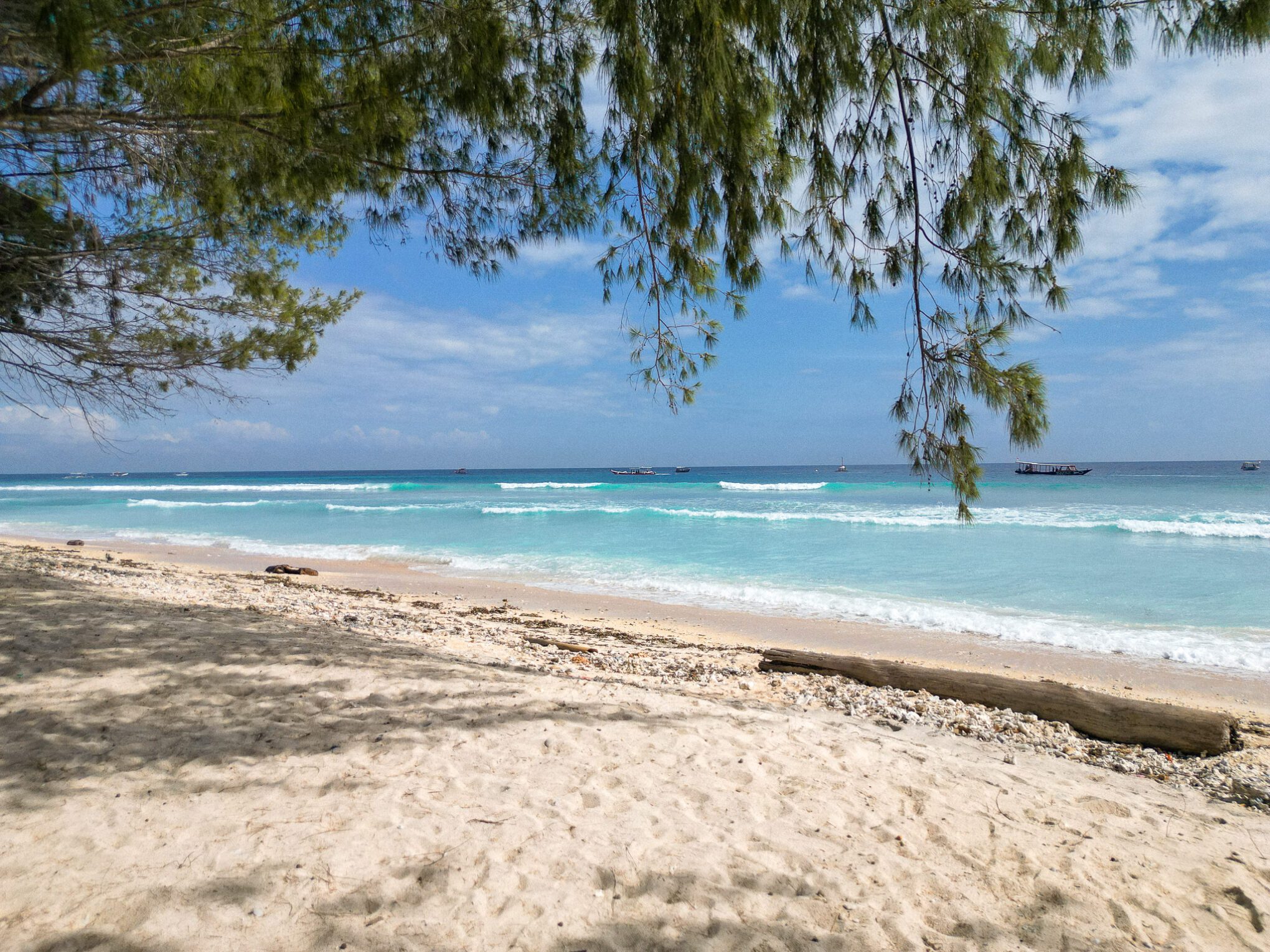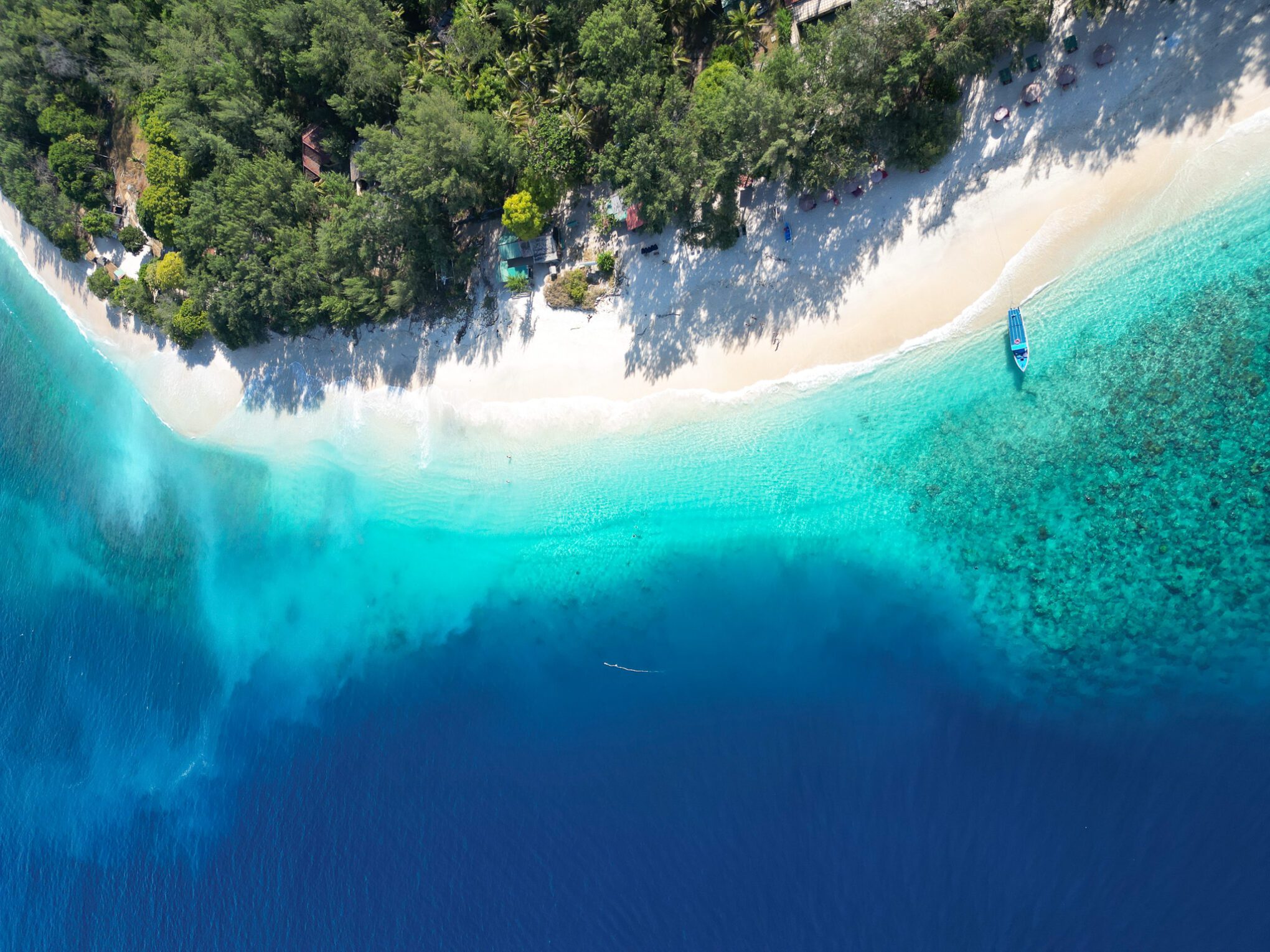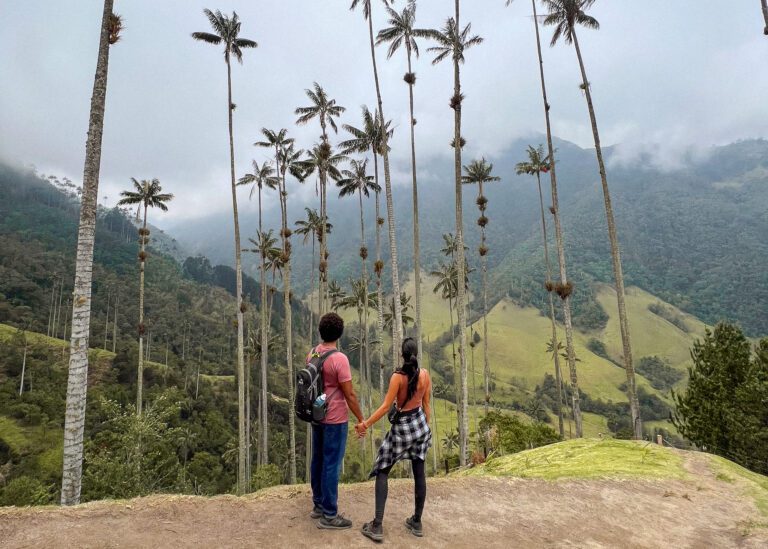The Gili Islands, a trio of small islands off the coast of Lombok, Indonesia, offer a paradise-like escape for travelers seeking everything from lively beach parties to quiet relaxation. Each island has its unique charm, and this guide will help you decide how to explore them, whether you’re island hopping or choosing a home base for day trips. We loved being able to explore three islands and can’t wait for you to experience them in your own ways.
Exploring Gili Trawangan

- The Biggest and Most Popular: Gili Trawangan, often referred to as “Gili T,” is the largest and most developed of the three islands. It’s renowned for its vibrant nightlife, making it a hotspot for young travelers and backpackers. During the day, you’ll find plenty of opportunities for bike rides around the island, snorkeling, and diving. Given that it is one of the most popular places to get scuba certified, it may be a great place to consider, with its numerous diving schools and vibrant marine life.
- Beaches: The best beaches for sunbathing and swimming are found on the north and west sides. Here, the sand is soft, white, and the waters are an inviting shade of turquoise. The beaches are perfect for unwinding after a day of activities or exploring.
- Sunrise & Sunset: For sunrise, head to the island’s eastern beaches, where the sun rises over Mount Rinjani on Lombok. For an unforgettable sunset, visit the west coast. Popular spots like The Exile offer a great sunset view with swings set in the shallow waters for the perfect Instagram shot.
- Where to Stay:
- Budget: Mad Monkey Hostel is a hotspot for young and budget travelers, known for its lively atmosphere, pool parties, and vibrant social scene. With a great restaurant and a prime location in front of a surf-friendly beach, it’s perfect for those looking to mix fun with affordability.
- Mid-Range: Trawangan Oasis offers quiet bungalow accommodations on the northern side, away from the busy party scene but still within walking distance.
- Luxury: Pearl of Trawangan is a luxurious beachfront resort with stylish rooms and stunning sea views. A wonderful place to return to after a day of exploring the island.
- What to Do:
- Scuba diving is a must-try here, with Gili T being a prime destination for exploring vibrant coral reefs and spotting turtles.
- Rent a bike and cycle around the island, which only takes about 1-2 hours.
- For nightlife, the strip near the port is lined with beach bars offering live music and parties.
- What to Eat: Gili Trawangan has a wide range of food options, from smoothie bowls and healthy salads at places like The Banyan Tree to local dishes such as nasi goreng and grilled seafood at beachfront warungs.
Visiting Gili Air

- Balanced and Authentic: Gili Air is the perfect mix of lively atmosphere and serene island life. It has an authentic, laid-back vibe, making it ideal for those who want to relax but still have access to social activities and bars. We really enjoyed the balance that this island had to offer.
- Beaches: The east and southeast beaches are the best for swimming and snorkeling. The nearby coral reefs are full of marine life, making it a great spot to spend a day exploring underwater.
- Sunrise & Sunset: For a serene sunrise, head to the eastern coast. For sunset, the western beaches provide a relaxed setting with beach bars offering drinks as the sky changes colors.
- Where to Stay:
- Budget: Sari Gili offers basic yet comfortable rooms at an affordable price, conveniently located near the island’s main attractions and the beach, making it ideal for budget travelers.
- Mid-Range: Mowies on the Beach offers cozy beachfront bungalows with spectacular sea views and a laid-back ambiance.
- Luxury: PinkCoco Gili Air offers luxury accommodations with elegant designs, beachfront access, and top-notch amenities.
- What to Do:
- Snorkeling is a popular activity, with trips organized to nearby spots like Turtle Point and the Gili Meno Statues.
- Yoga classes are available around the island, making Gili Air a great place for wellness and mindfulness activities.
- You can also visit local crafts markets or take a cooking class to learn how to make traditional Indonesian dishes.
- What to Eat: Gili Air is known for its organic cafes serving smoothie bowls, fresh fruit salads, and international cuisine. Warungs also offer a taste of Indonesian flavors like sate, spicy sambal, and fresh grilled fish.
Traveling to Gili Meno

- The Smallest and Quietest: Gili Meno is the most tranquil of the three islands, perfect for honeymooners and travelers seeking peace and quiet. It’s less developed than Gili T and Gili Air, providing a more laid-back, untouched vibe.
- Beaches: Gili Meno is home to some of the most stunning beaches, particularly on the west and southwest coasts. These beaches have soft white sand and crystal-clear waters, perfect for swimming, sunbathing, and snorkeling. A lot of the beaches also contain coral and can be a bit rocky, so expect that as you explore different parts of the island.
- Sunrise & Sunset: Catch the sunrise from the island’s east coast. The western side, especially around the southwest, offers a quiet, serene sunset experience with few crowds.
- Where to Stay:
- Budget: Nura Homestay offers affordable, simple accommodations within walking distance of the beach.
- Mid-Range: Seri Resort Gili Meno is an elegant beachfront resort with bungalows and beautiful views, making it a peaceful retreat.
- Luxury: BASK is a luxurious beachfront resort with elegant villas, private pools, and stunning sunset views for a relaxing escape.
- What to Do:
- Visit the famous underwater sculpture garden, perfect for a snorkeling trip, right in front of BASK Resort.
- Turtle watching is also popular, with a turtle sanctuary on the island working to conserve the species.
- For a peaceful day, rent a cabana and enjoy the quiet beaches.
- What to Eat: Gili Meno offers a few beach cafes serving healthy options, as well as local warungs offering gado-gado (vegetable salad with peanut sauce) and fresh grilled seafood. More local places can be found as you go in closer to the center of the island.
Getting to the Gili Islands

There are several options for reaching the Gili Islands from Bali or Lombok. However, it’s important to note that boat rides from Bali can be bumpy, especially during certain seasons. Be sure to prepare for the ride by bringing motion sickness medication if you’re prone to seasickness.
Traveling to Gili Islands From Bali
- Fast Boat from Padang Bai or Sanur: The most popular route is by fast boat from Bali. It takes about 1.5 to 4.5 hours depending on the company and departure point. Fast boats run frequently from Padang Bai and Sanur, with prices ranging between IDR 250,000 – IDR 500,000 ($15-$35 USD) per person.
Traveling to Gili Islands From Lombok
- Public Ferry: From Lombok, take a short ferry from Bangsal Port. The ferry ride is about 10-15 minutes and is significantly cheaper, making it a preferred option if you’re already in Lombok. It’s ideal for visitors who want to explore both Lombok and the Gilis.
- Private Charter: If you want a more comfortable journey, private charters are available. They provide a faster and smoother ride, though they are significantly more expensive than the public options.
Arriving to the ports
Unless tickets are booked with an agency, private transport to each port is required. Normally Grab/Gojeks are available to the ports, but not leaving from there, as the local taxi companies forbidden their access. We recommend arranging this before.
Preparing for Your Trip to the Gili Islands

Whether you’re staying for a few days or a week, packing for the Gilis is essential to ensure you’re well-prepared for the island’s tropical climate and outdoor activities. Here are some important things to keep in mind:
- Proper Clothing: Light, breathable fabrics are key. Be sure to bring plenty of sun protection, including a wide-brimmed hat, sunglasses, and long-sleeved UV-protective shirts if you plan on spending a lot of time in the water.
- Sunscreen: The sun can be intense, so bring reef-safe sunscreen to protect your skin without harming the coral reefs. This is especially important if you’re planning to snorkel or dive.
- Snorkeling Gear: Although you can rent snorkel gear on all three islands, it might be more convenient to bring your own. This way, you can snorkel anytime without needing to find a rental shop.
- Shoes for Walking: Since motorized vehicles are banned on the islands, you’ll be walking or biking most of the time. Comfortable sandals or walking shoes are a must, especially if your accommodation is a bit further from the port.
- Daily Necessities: While the islands have shops selling items like snacks, toiletries, and beachwear, they can be more expensive than mainland Bali or Lombok. If you have any specific needs (sunscreen, aloe vera, etc.), it’s best to bring them with you.
Tides and Beach Conditions
Being on an island, the tides in the Gili Islands significantly impact beach conditions. At low tide, the beaches may expose rocks and coral, making it more difficult to swim. High tide brings in full, beautiful beaches perfect for lounging and swimming.
To plan your beach days around the best tide times, use apps like Tideschart.com or check local tide boards near the ports. These resources will show you daily tide times so you can plan activities like snorkeling, diving, or swimming at the most optimal times.
Local Sellers and Souvenirs

As you walk around the Gili Islands, you’ll notice plenty of local vendors selling everything from beach towels to handmade jewelry. It’s common to see people walking along the beaches offering to sell souvenirs, so don’t be surprised if you’re approached while sunbathing. This can include locally made items such as:
- Towels and Sarongs: Perfect if you need a beach towel or just want a beautiful, locally made sarong as a souvenir.
- Jewelry and Accessories: You’ll find bracelets, necklaces, and other accessories made from natural materials like coconut shells, wood, or beads. Many vendors also sell items made from pearls, especially those sourced from nearby Lombok.
- Handicrafts: Local handicrafts such as woven bags and baskets are popular souvenirs, often handmade by artisans from Lombok or Bali.
Prices can vary, so it’s a good idea to practice your bargaining skills when purchasing from local vendors. This is part of the culture, and while haggling is expected, be respectful and fair when negotiating prices.
Things to Keep in Mind:
- Prayer Broadcasts: All Gili Islands have mosques that broadcast prayers several times a day. Some areas are closer to the mosques and may be louder, while others are quieter. Keep this in mind when booking accommodation.especially if you’re a light sleeper or prefer a quieter setting during your stay.
- Best Travel Season: The best time to visit the Gili Islands is during the dry season (April to October). The wet season (November to March) can bring rain and choppier seas.
- Holidays & Closures: Be sure to check for local holidays, as some restaurants, markets, and attractions may be closed during these times.
- Water Quality: Drink only bottled or filtered water. Tap water is not safe to drink.
- Mosquitos: Mosquitoes can be present, especially in the evening. Bring repellent or purchase some on the islands.
- Cash & ATMs: Although ATMs are now available on most of the islands, it’s still a good idea to carry some cash, especially for smaller vendors or in case of island outages.

BONUS: 5-7 Day Gili Islands Itinerary
Option 1: Island Hopping (7 Days)
- Days 1-2: Gili Trawangan
Begin your journey on Gili Trawangan. Explore its lively party scene, indulge in diving or snorkeling, and unwind on the quieter northern beaches. Don’t miss the sunset from the western shore. - Days 3-4: Gili Air
Next, take a short boat ride to Gili Air. Snorkel in the eastern waters, join a yoga class, or enjoy beachside relaxation at a local cafe. Evenings can be spent at beachfront bars watching the sunset. - Days 5-7: Gili Meno
End your trip on the quietest island, Gili Meno. Enjoy peaceful beach days, visit the underwater sculptures, and take in the tranquility. Spend your last evening watching the sun set over the calm waters.
Option 2: Home Base + Day Trips (5-7 Days)
For a more relaxed experience, choose either Gili Air or Gili Meno as your home base and take day trips to the other islands.
- Days 1-5: Stay on Gili Air or Gili Meno
Gili Air is ideal for travelers who want a bit of activity, while Gili Meno is perfect for those seeking quiet and seclusion. Spend your days snorkeling, exploring the local cafes, and relaxing on the beach. From here, you can easily take day trips to the other islands.- Day trip to Gili Trawangan: On one of the days, take a short boat ride to Gili T for a day of adventure, bike riding, and a taste of the island’s lively atmosphere. Return to your peaceful base at the end of the day.
- Day trip to Gili Meno (if staying on Gili Air): Spend a day on the serene Gili Meno. Relax on its beaches, visit the turtle sanctuary, and enjoy a peaceful afternoon before heading back.
- Days 6-7: Wind Down on Gili Meno (or Air)
No matter where you choose as your base, spend your last two days relaxing. Watch a sunset on the west coast, enjoy a final snorkel session, and soak up the last bits of island life.

The Gili Islands offer something for every type of traveler, from the party-seeking backpacker to the honeymooner in search of peace and serenity. Whether you choose to island hop or base yourself on one island, this guide provides the perfect balance of relaxation and adventure for your 5-7 day itinerary.
From the best places to watch the sunset to must-visit snorkel spots and top accommodation choices for all budgets, the Gilis are an unforgettable destination where you can immerse yourself in island life. It has been home to some of our favorite experiences during our time in Indonesia. So pack your essentials, prepare for a bumpy boat ride, and get ready to explore the stunning Gili Islands!


